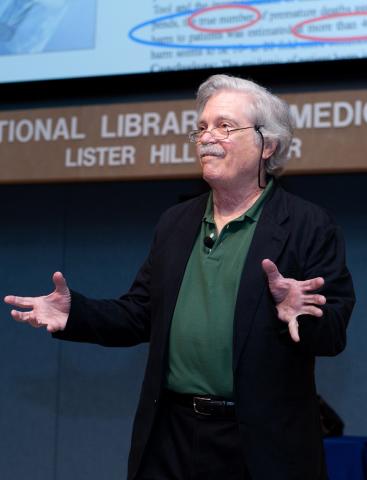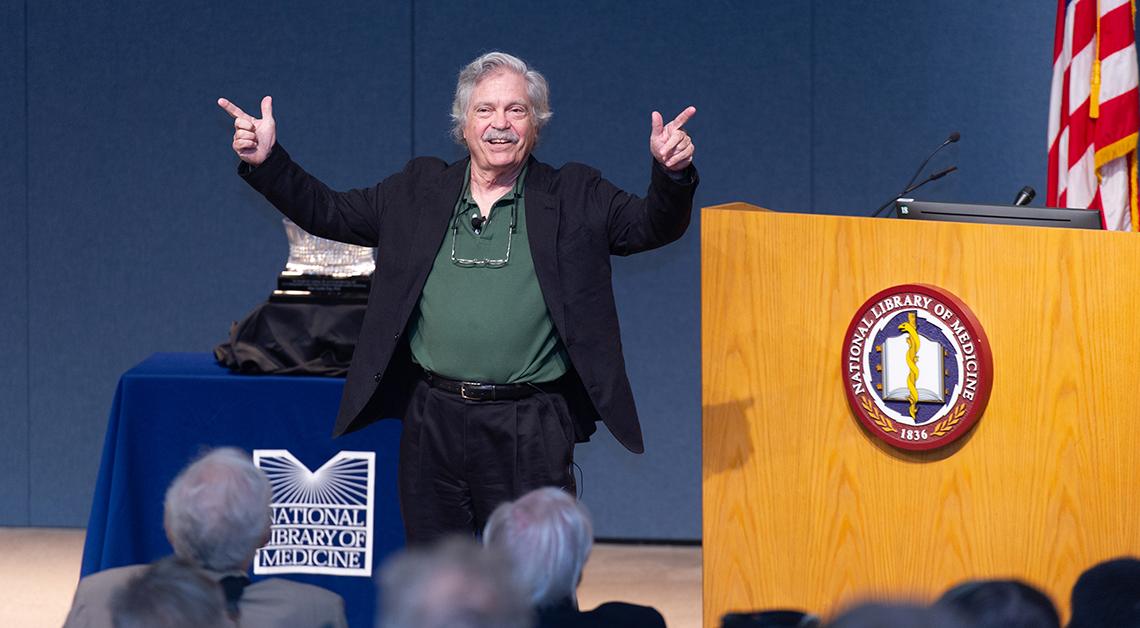‘Blind’ Man Gazes into Future
The most reliable assurance of a successful, and healthy, future is to send emissaries—our children—to that far-off place who are armed with education, grounded in reality and disciplined enough to work toward the brighter angels of their imaginations.

Photo: Marleen Van Den Neste
So argued one of the people responsible for our current reality, at least as far as technology is concerned: Dr. Alan Kay, one of the pioneers of graphical user interfaces and modern computing. An original member of the Xerox-PARC group and a Turing Award winner, he addressed the topic, “Is it too late to invent a healthy future?”
Early in his presentation of the National Library of Medicine’s annual Lindberg-King Lecture recently, Kay, who is now president of the Viewpoints Research Institute and adjunct professor of computer science at UCLA, called computing, his field of technology, “almost blind—it relies on little to no human context or history.”
Not only is it blind to the world in which it is pursued, but also it may be an example of what Kay called “inverse vandalism—making things just because you can” borne of “a misplaced desire to make things.
“The future, to me, is not the next 5 years, or the next 10 years,” he said. “I see it extending in front of us at least as far as our era…one hundred, or a few hundred years ahead is a useful way to think about it.”
A child born today will be 82 in 2100. “Will the child get there at all? Could things be better then?”
Recent human history can make one a pessimist, he suggested. There have been 43 genocides in the 60 years spanning 1956-2016, according to the Political Instability Task Force, resulting in some 50 million deaths.
This does not even take into account the purges under Stalin and the Nazi Holocaust, which acutely affected a 7-year-old Kay as he saw, in the pages of Life magazine, Margaret Bourke-White’s ghastly images of the concentration camp at Buchenwald.
“I had never seen anything like this,” murmured Kay, still stunned. “That incident marked me for life.”
His argument is that human societies that readily tolerate extreme—and even normalized—violence, such as ravaged Rwanda in recent decades, need to take a hard, fresh look at what constitutes mental health. “This is starting to look like normal behavior—like war—not off-to-the-side behavior…massacres and lynchings and murders are still happening.”
When “normal” people are okay with genocide, maybe normal needs a reboot.
Kay likes a quote from Albert Einstein: We cannot solve our problems with the same kinds of thinking we used when we created them.
The good news, Kay said, is that places like NIH and the National Science Foundation are good at creating able emissaries to the future.
Musing on the topic of what children can learn, Kay quipped, “Adults think the best idea is to turn out people who are just like them. Which is a dumb idea, even if you’re good.

Photo: Marleen Van Den Neste
“By far, the best way to predict the future,” he said, returning to his topic “is to invent the children who will invent the healthy future.”
Kay remains acutely skeptical of what constitutes normality. Given that about a quarter of a percent of the population—outliers, not the norm—usually consider themselves conscientious objectors, “that means that 99.7 percent think it’s okay to kill. It’s completely normal to be willing to kill others if your culture says it’s okay.”
Which is a scary concept given that recent studies of cognitive bias prove that “humans are basically delusional—we project our beliefs out into the world.”
Kay paused to challenge, in a friendly way, NIMH director Dr. Josh Gordon, who was in the Lister Hill Auditorium audience: “NIMH is not involved with ‘normal’ human mental disorders of thinking and behavior that are so disastrous to civilization and life. It’s not part of NIMH’s charge.”
Kay concluded with advice on “how not to get trapped by our bad brains.” Oddly enough, it involved Ted Williams, arguably the greatest hitter baseball has ever seen.
To make himself a better hitter, Williams invented the batting tee, said Kay. It enabled him to perfect the difficult task of “hitting one round thing with another round thing.”
What is the tee-ball of math and logic, and of science and computing for kids? Kay asked, proceeding to offer graphic examples using Tinker toys, Play-Doh and even the video capabilities of a smartphone.
Given instruction, repetition, plenty of practice time and a good dollop of social sharing, humans—even with the burden of their past animal minds—can do some amazing and beneficial things, he said.
Ever the diagnostician of systems, Kay had a final challenge for NIH’ers: There is a shortfall of about 1 million elementary school teaching aides in science and math in the U.S., but around 2 million people age 65-70 with STEM backgrounds who could help. At NIH alone, he said, there are about 9,000 people who could be helping kids better cope with a looming future.
“You could make an enormous difference,” said Kay, “if you got out there and helped the existing elementary school teachers.”
The Lindberg-King Lecture honors former NLM director Dr. Donald Lindberg and former NLM deputy director for research and education Dr. Donald West King. Lindberg was on hand to present a crystal bowl to Kay in honor of the occasion.
